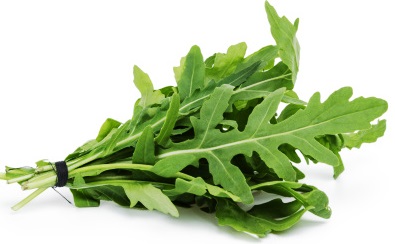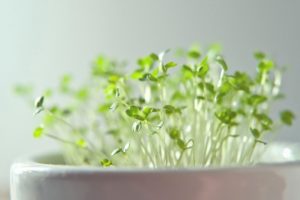Arugula with its aromatic, peppery flavour adds wonderful benefits and dimension to a salad and to your sex life too. It is also known by other names such as salad rocket, garden rocket, roquette, rucola, rugula, or colewort. The scientific name of arugula is Eruca sativa.
”Arugula is an elixir that gives flavor to life.”
– Dennis Lybeer
9 Arugula Health Benefits
- Cancer-fighting powerfood
Arugula is one of the brassica family vegetables along with broccoli, cauliflower and cabbage. These vegetables are high in fibre and antioxidants, and also rich in glucosinolates, studies show may reduce the risk of developing lung, prostate, breast, and pancreatic cancer. - Rich in chlorophyll
Chlorophyll can help to prevent liver and DNA damage from aflatoxins . To get the most chlorophyll in arugula, it is best to eat it raw.
Greens are always good for you but arugula is one of the best! - Hydrating leafy green
It is composed of mostly water; containing a 90% water so is a great hydrating and cooling food in the summer. - Good for bone health
Vitamin K is needed for bone health; it is needed for the absorption of calcium into the bones and teeth. Half a cup of arugula contains 10.9 micrograms of vitamin K. Three cups of arugula daily will supply you with 100% of your bodies need of vitamin K. It also contains eight times more calcium than iceberg lettuce. - Helps reduce inflammation in the body
It contains indole-3-carbinol and isothiocyanates which have been shown to suppress the production of inflammation in the body.
By reducing inflammation arugula increases energy and mobility. - Cleanses and detoxifies the body
The fiber content helps clean out the colon promoting healthy bowel movements. The phytochemicals, antioxidants and essential minerals found in arugula help cleanse out toxins in the body. - Protect the aging brain and cognitive decline
It is high in most of the B vitamins but contains especially high amounts of folate. In high-functioning older adults, low levels of folate have been shown to be a risk factor for cognitive decline. - Weight loss
Arugula in your diet can benefit you with so many nutrients and the extra benefit is that 2 cups contains only 80 calories, making it a good choice for those on a diet. - Aphrodisiac
This is a wonderful health benefit of arugula. It has been used as an aphrodisiac since the first century. Research has shown us that the trace minerals and antioxidants in dark, leafy greens are essential for our sexual health. They help block environmental contaminants which are thought to be negative to our libido.
A study found that arugula leaf extracts boosted testosterone levels and sperm activity in mice. The results suggest that the phytochemicals and/or nutrients in it may have aphrodisiac properties. – Published March 2013 in Journal of Al-Nahrain University
“The rocket excites the sexual desire of drowsy people.” – from a poem, by Virgil, one of Rome’s greatest poets.
Trivia:
- Arugula was used as a potent aphrodisiac during the ancient civilization of Rome.
- Love potions were made using arugula and other herbs like lavender in ancient times.
- The seeds are pressed to make Taramira oil, used in pickling, cooking, and salad dressing in northern India.
- Ancient Romans ate it for good luck.
Tips for eating or cooking to get the health benefits of arugula:
This green is popular in Italian cuisine.
Eating arugula raw will likely provide your body with more of the healthy isothiocyanates than eating cooked arugula.
Eating lightly cooked arugula, your body will absorb more of certain nutrients and carotenoids than when it is raw.
Please Note: Arugula is relatively lower in oxalate content than in spinach, purslane, mustard greens, celery, etc. The greens can be safely used during pregnancy and lactation.
Arugula Nutrition:
- It is full of the minerals copper, calcium, iron, potassium, manganese and phosphorous.
- High in Vitamin C, Vitamin A, and Vitamin K.
- Also rich in thiamin, riboflavin, niacin, vitamin B-6 (pyridoxine), and pantothenic acid.
- Arugula is low in oxalates which is good because oxalates inhibit mineral absorption in the body. Spinach has high levels of oxalate.
History:
- In Roman times Arugula was grown for it’s leaves and the seed. The seed was used for flavoring oils.
- Arugula seed has been used as an ingredient in aphrodisiac concoctions dating back to the first century, AD. (Cambridge World History of Food).
- Arugula blossoms and leaves have been a popular ingredient in the cuisines of Italy, Morocco, Portugal and Turkey.
- Arugula was brought to America by British colonists but it was not until the 1990’s that arugula became a culinary ingredient in the United States.
Grow Your Own Arugula At Home
Arugula’s well-known name as ‘rocket’ is because of its rocket-fast growth speed.
It’s easy to grow arugula as it is drought resistant, grows in dry disturbed soil and grows up fast in short period.
Simply sow the seeds in a sunny location approximately every 20 to 30 days from early spring to fall.
It does flower and goes to seed quickly. Collect seeds for growing more arugula.
Harvest
Simply pick the young leaves and the plant will keep creating more leaves for months. The older leaves are a bit hotter. The flowers are great in salads.
How to Store Arugula
Put in a plastic or a zip lock bag and store in the fridge. They usually last up to one week.
“Arugula, arugula wherefore art thou?”
– Diana Herrington

My Favorite Arugula Recipes to Enjoy the Benefits
Arugula Pesto: This tasty recipe achieves a cheesy flavor without dairy.
Quinoa Arugula Salad: Full of protein from the quinoa and pumpkin seeds, this can be a meal all by itself.
You can also learn how to plan and prepare super healthy meals with my
2-5-30 Healthy Diet Online Courses.




GREAT !! THANK YOU.
Am so enriched by your health way of cooking teachings
Thank you for your appreciation. Do feel free to share any good tips you may have on cooking.